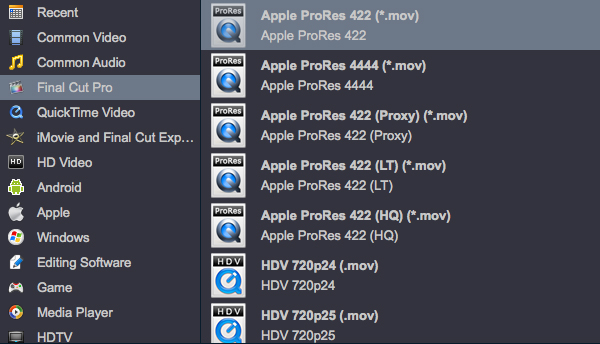
The Panasonic Lumix DC-GH7 is the latest in Panasonic's line of high-end cameras historically aimed at video shooters. We say 'historically' because the GH7 makes a strong case for being a true photo-video hybrid. There's no longer a need to adjust audio recording levels during shooting - with 32-bit float recording using the optional DMW-XLR2 adapter and internal recording of 5.7K 30p Apple ProRes 422 HQ and Apple ProRes RAW HQ. If you are a user of this camera and plan to edit recorded videos in video editing software such as Final Cut Pro, you will encounter similar issues as below.
"Trying to read 5.7K H.265 MOV from Panasonic Lumix DC-GH7 in Final Cut Pro 10.1.1 (not studio) in macOS Monterey. Unable to even read the file, keep getting "Media offline", tried 4 different videos, same issue on all of them. No problem with ProRes RAW clips. This is my first go with h.265, anyone experienced this?"
"I can't play the loaded GH7 videos in Final Cut Pro, why? It's frustrating to spend a lot of time rendering videos every time."
"So this only seems to happen with MOV footage in Final Cut Pro 10.5 . If I keep hardware accelerated decoding checked in Preferences while working with them, I get seemingly random "media offline" placed all over my media. Like, a few seconds of the actual video plays, and then media offline for like 0.5 - 3 seconds, then a few seconds of video, then media offline again, etc... Turning off Hardware Accelerated Decoding fixes it and allows me to work better, but I would prefer having my GPU do the heavy lifting of decoding."
More and more phones and prosumer cameras using the H.265 codec, which is much more efficient than H.264 when it comes to compress videos for saving space and reducing the pressure of bandwidth while data transferring. However, editing Lumix GH7 H.265 MOV videos isn't an easy thing. Even those users who work with the professional Final Cut Pro are reporting various problems, such as unable to read the file, keep getting "Media Offline" or "choppy or lagging video playback" after importing. If you're encountering those issues when working with Lumix GH7 H.265 MOV in Final Cut Pro, here's what you need to know, also we will introduce an easy solution to fix the issues.
If you're currently not planning to make the upgrade, how can you edit Lumix GH7 videos in Final Cut Pro smoothly? Transcoding H.265 to Apple ProRes codec for Final Cut Pro is the best solution to improve performance, stability and reliability throughout your post production workflow. And "transcoding" is also recommended by Final Cut Pro officially.
Best Tool to Converting Luix GH7 MOV to High-Qaulity Codec for Final Cut Pro
HEVC files are heavily compressed formats and while not ideal for editing in Final Cut Pro and other video editors. Let's not to say some 10-bit H.265 footage shot in Panasonic Lumix GH7. Then, transcoding H.265 files becomes a highly recommended method, especially if your files are in 5.7K/5.8K/4K H.265 and you don't have a high-end computer.
For the highest quality and smooth editing, you're recommended to transcode Lumix GH7 H.265 MOV to Apple's ProRes codec - the files are way too big for sharing on the web conveniently - but the compression is minimal so the quality remains very high. I've yet to find a good free transcoder that meets those requirements, but there are some paid apps that can do it. The world of paid video transcoding apps is quite a mess. Some are very good, but some are downright dodgy. I'm not going to go down that rabbit hole, but there is an easy-to-use yet powerful tool that really work for this:
Acrok Video Converter Ultimate - There are versions for Mac and Windows.
With it, you can easily and fast transcode any Final Cut Pro incompatible video files including but not limited to MXF, MTS/M2TS, MKV, VOB, MOV, H.265 to high-quality Apple ProRes codec. These formats can be well compatible with Final Cut Pro. The ProRes preserve the best image quality and provides better performance when editing in Final Cut Pro (FCP X, FCP 7, FCP 6), but creates much larger files that use more storage space than H.265 file use. Apart from changing file format, Acrok Video Converter Ultimate (For Mac | For Windows) can also rip/convert Blu-ray/DVD to any video/audio format.
How to Convert Lumix GH7 H.265 MOV to ProRes for Final Cut Pro
Step 1. Add Lumix GH7 videos
After downloading, install and run Acrok Video Converter Ultimate as the best H.265 to Final Cut Pro Converter and MOV to Final Cut Pro Converter, simply drag and drop your Lumix GH7 files to the software. You can also click "Add File" button to load your source files. (Note: batch conversion is supported, so you can load more than one file to save time.)

Step 2. Choose ProRes MOV as the output format
The "Format" tray locates in the buttom of the window. From "Final Cut Pro" you can select "Apple ProRes 422 (*.mov)" or "Apple ProRes 4444 (*.mov)" as the output file. Both of the profiles can generate files with best image quality and better editing performance for Final Cut Pro use.

Tip: You can edit Lumix GH7 video before conversion. If your editing software supportes 1080P - 8K resolution editing, please set the output video resolution as "Original".

Step 3. Start conversion
When everything is done, simply click the "Convert" button and the program will start converting your Lumix GH7 files rapidly. Once done, you can click "Open" button to get the exported ProRes codec for editing in Final Cut Pro with optimum performance. That's all, you can import and edit Lumix GH7 H.265 MOV files in Final Cut Pro smoothly.










